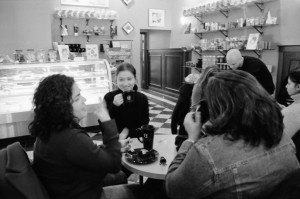Last Wednesday, I started to develop my three functions model, by exploring representation in-depth.
- Representation
- Planning
- Delivery
This is the second of three posts about representation:
- Provide a meeting place
- Generate and record deep conversations
- Agree a community plan
Many groups have problems encouraging conversations even though they can get people together. Understanding conversations is essential for community development online as well as off and so I have written about them in some detail.
With BCAF (Burngreave Community Action Forum) we managed to bring over 60 people together once a quarter for many years. Why did they attend these meetings? They cared about their neighbourhood and its development. They also turned up to socialise and share in a good free lunch.
So, what did BCAF do? In the early days, we sat people in rows and invited decision-makers to address the meeting. They were willing to come out on a Saturday morning because they knew they would get a good-sized audience. But these meetings became tedious. They often went on for far too long because everyone wanted a say following each presentation.
The problem was conversations were not taking place in any depth. Contributions from the floor were often a view already formulated before the presentation. Other people came to complain about something and introduced it when they could, unrelated to the presentations’ contents.
Eventually we worked out people needed time to talk in groups and after experimenting with buzz groups and break out groups we eventually worked out we would be better off sitting people in groups for the entire meeting. This reduced time moving between groups and helped buzz issues between presentations. (Tables also provided somewhere to balance plates of food!) There are drawbacks, most notably difficulties for the hard of hearing but on balance it’s the best way we found.
Groups can be supplied with hand-outs and flipchart paper with pens. The latter allows for written as well as verbal feedback.
A lot more can be written about this approach and I’d like to hear whether you have used it and with what results.
Conversations in a Community Cafe
 But what about conversations in a community café?
But what about conversations in a community café?
The first thing to note is conversations will take place all the time. People can be invited to complete a brief form with contact details and a brief account of their issue, idea or concern. This may be something they bring to the café to share as a concern. Or maybe something arising from general conversation and that’s worth sharing.
If you have a local concern and want to canvass views, it can be outlined on notice boards or a stall. People might be invited to complete a questionnaire or leave their contact details if they wish to support a campaign. People might be invited to discuss an issue at their tables at publicised times . This would be an opportunity for key people to listen to conversations. Or key people can circulate at any time and ask a table if they would be willing to discuss their issue.
Participative appraisal (PA) is a helpful approach. It is a number of tools, mostly pen and paper, with a philosophy of deep listening. This enables any participant to ask questions and involves everyone; their voices not drowned by the more vocal.
The layout and history of your centre will help you work out how to canvass views; simply try things to find out what works. But what if you want to take things further and agree a community plan?
Leave a comment and tell me about your experience of community planning. I’ll offer some tips next time.